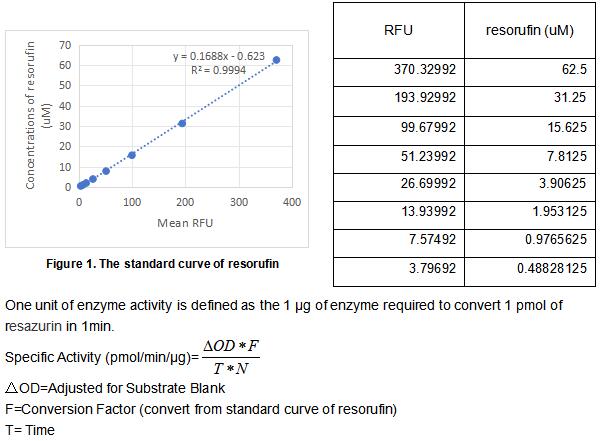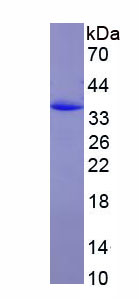Active NADH Dehydrogenase, Quinone 1 (NQO1) 

DHQU; DIA4; DTD; NMOR1; NMORI; QR1; Azoreductase; DT-diaphorase; Menadione reductase; Phylloquinone reductase; Quinone reductase 1; NAD(P)H:quinone oxidoreductase 1
- UOM
- FOB US$ 227.00 US$ 568.00 US$ 1,136.00 US$ 3,408.00 US$ 8,520.00
- Quantity
Overview
Properties
- Product No.APL969Ra01
- Organism SpeciesRattus norvegicus (Rat) Same name, Different species.
- ApplicationsCell culture; Activity Assays.
Research use only - DownloadInstruction Manual
- CategoryEnzyme & Kinase
- Buffer FormulationPBS, pH7.4, containing 0.01% SKL, 5% Trehalose.
- Traits Freeze-dried powder, Purity > 90%
- Isoelectric Point8.4
Sign into your account
Share a new citation as an author
Upload your experimental result
Review

Contact us
Please fill in the blank.
Activity test

NAD(P)H:quinone acceptor oxidoreductase 1 (NQO1), also known as DT-diaphorase, is a widely-distributed FAD-dependent flavoprotein that promotes 2-electron reductions of quinones, quinoneimines, nitroaromatics, and azo dyes. As a result it prevents the one electron reduction of quinones that results in the production of radical species. NQO1 is a highly-inducible enzyme that is regulated by the Keap1/Nrf2/ARE pathway. The increase and decrease of NQO1 levels are associated with decreased and increased susceptibilities to oxidative stress, respectively. Thus, NQO1 is a marker cytoprotective enzyme in oxidative stress. Independently of its catalytic function, NQO1 plays a role in regulating the proteosomal degradation of p53, p73a, and p33. NQO1 physically interacts with p53 and p73 in an NADH-dependent manner and protects them from 20S proteasomal degradation in a ubiquitin independent pathway. The activity assay of recombinant rat NQO1 was measured by its ability to oxidize the substrate resazurin to resorufin. The rrNQO1 was diluted to 0.05 ug/ml in the assay buffer 50 mM HEPES, 0.2 M NaCl, 5 µM FAD, 0.05% Tween® 20, pH 7.5. 50 ul 0.05 ug/ml rhNQO1 was added into the microplate and start the reaction by adding 50 µl substrate mixture of 400 uM beta-NADH and 20 uM resazurin which was diluted in assay buffer. Read at excitation and emission wavelengths of 540 nm and 585 nm (top read), respectively, in kinetic mode for 5 minutes. The specific activity of recombinant rat NQO1 is >45000 pmol/min/µg.
Usage
Reconstitute in 10mM PBS (pH7.4) to a concentration of 0.1-1.0 mg/mL. Do not vortex.
Storage
Avoid repeated freeze/thaw cycles. Store at 2-8°C for one month. Aliquot and store at -80°C for 12 months.
Stability
The thermal stability is described by the loss rate. The loss rate was determined by accelerated thermal degradation test, that is, incubate the protein at 37°C for 48h, and no obvious degradation and precipitation were observed. The loss rate is less than 5% within the expiration date under appropriate storage condition.
Increment services
-
 BCA Protein Quantification Kit
BCA Protein Quantification Kit
-
 Molecular Mass Marker for Protein
Molecular Mass Marker for Protein
-
 Monoclonal Antibody Customized Service
Monoclonal Antibody Customized Service
-
 Polyclonal Antibody Customized Service
Polyclonal Antibody Customized Service
-
 Protein Activity Test Experiment Service
Protein Activity Test Experiment Service
-
 Electrophoretic Mobility Shift Assay (EMSA) Experiment Service
Electrophoretic Mobility Shift Assay (EMSA) Experiment Service
-
 Buffer
Buffer
-
 Lentivirus Packaging Experiment Service
Lentivirus Packaging Experiment Service
-
 Adenovirus Packaging Experiment Service
Adenovirus Packaging Experiment Service
-
 Real Time PCR Experimental Service
Real Time PCR Experimental Service
-
 Spike RBD Protein (S-RBD)
Spike RBD Protein (S-RBD)
-
 Protein G
Protein G
-
 Protein A
Protein A
Citations
- Transcription factor Nrf2 protects renal dopamine D1 receptor function during oxidative stress.Pubmed: 23876469
- Notoginsenoside R1-mediated neuroprotection involves estrogen receptor-dependent crosstalk between Akt and ERK1/2 pathways: A novel mechanism of Nrf2/ARE signaling activationInformahealthcare: Source
- Antioxidant resveratrol restores renal sodium transport regulation in SHRPubMed: 26603454
- Genetic association of NAD (P) H Quinone Oxidoreductase (NQO1* 2) polymorphism with NQO1 levels and risk of diabetic nephropathyPubmed:27078674
- Sodium arsenite augments sensitivity of Echinococcus granulosus protoscoleces to albendazolePubmed: 30790573
- Gold Nanoparticles Perturb Drug-Metabolizing Enzymes and Antioxidants in the Livers of Male Rats: Potential Impact on Drug InteractionsPubmed: 32764932
- In vitro protoscolicidal effects of lithocholic acid on protoscoleces of Echinococcus granulosus and its mechanismPubmed:35594934







